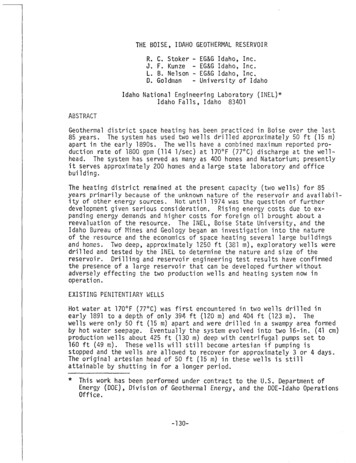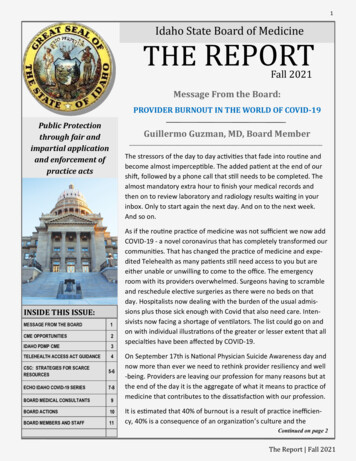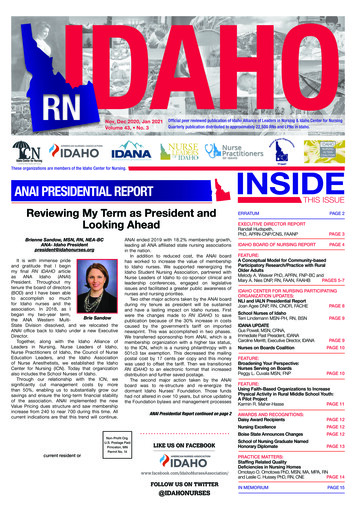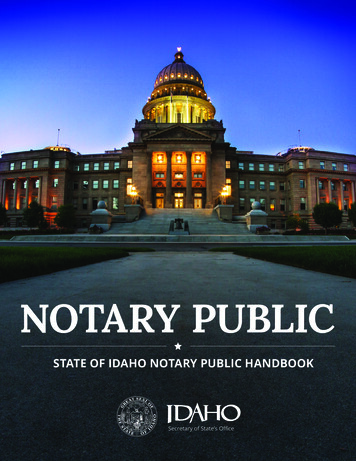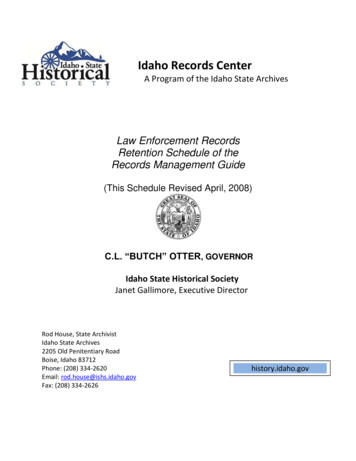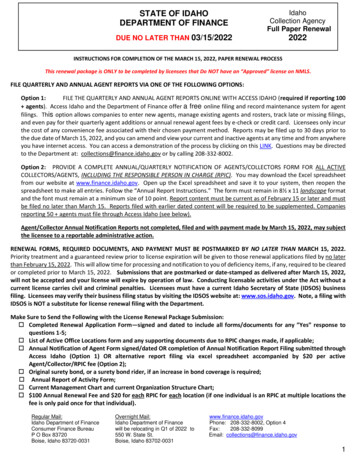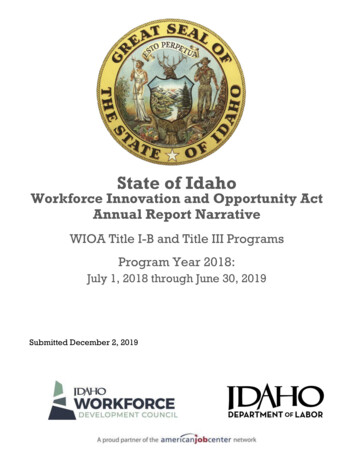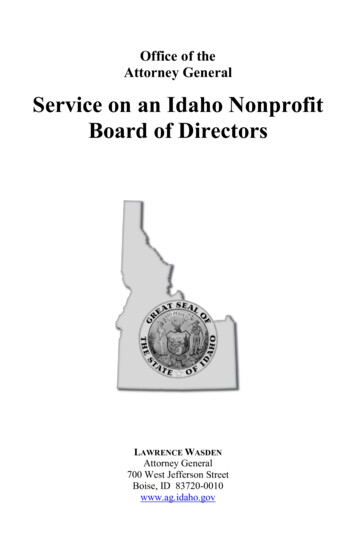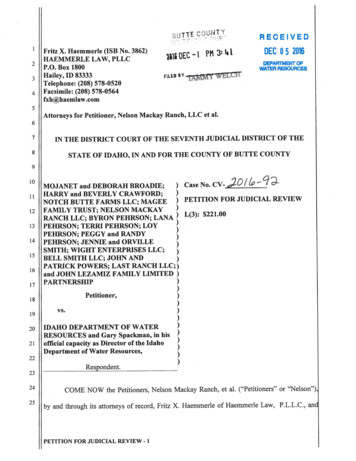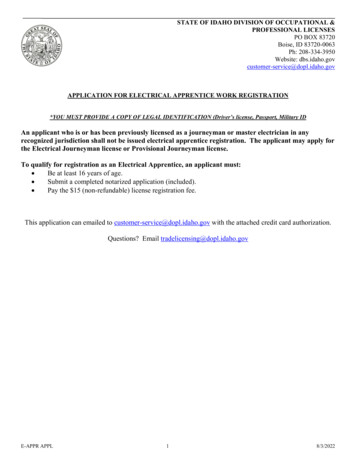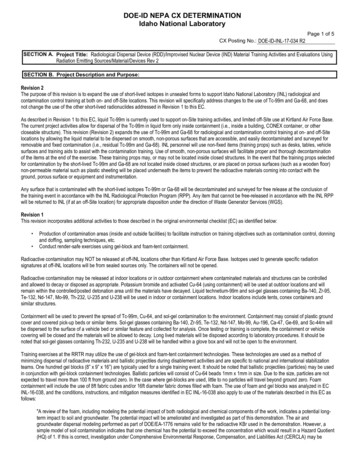
Transcription
July 1, 2014THE HONORABLE C. L. “BUTCH” OTTERGOVERNOR, STATE OF IDAHODear Governor Otter:I am pleased to submit herewith the 109th Annual Report of the Department of Finance for fiscal year 2014,July 1, 2013 through June 30, 2014.The Department’s mission is to aggressively promote access to vigorous, healthy and comprehensive financialservices for Idahoans. This is accomplished through prudent and efficient oversight of financial institutions,investment opportunities and credit transactions. Department financial services sector licensing andregistrations increased about 5 percent over last fiscal year. As a result, the Department was able to transfer 4.95 million to the State’s General Fund. Finally, Department enforcement actions resulted in nearly 5.6million in restitution/rescission/refunds ordered for the benefit of Idaho residents.Idaho’s one bank failure during fiscal year 2014, Syringa Bank in Boise, was closed on January 31, 2014. Itwas the first Idaho state-chartered bank to close since 1986. There were no credit union failures in Idahoduring the fiscal year. Nationally, there were 17 bank failures and 8 credit union failures, whereas last yearthere were 36 and 17 respectively. Seven Idaho credit unions and banks merged during fiscal year 2014,continuing a state and national consolidation trend.In continued support of Idaho community banks, the Department again participated in a national communitybanking research and policy initiative sponsored by the Federal Reserve System and the Conference of StateBank Supervisors (CSBS). The initiative focuses on the challenges and opportunities facing community bankscurrently and in the future, with the goal of developing policy initiatives to support the vital role of communitybanks.We are proud to report that the Department’s Consumer Finance Bureau Mortgage Section was among the firstregulators to achieve accreditation, recognizing the Bureau’s ability to meet the unique financial needs of localeconomies and citizens. Additionally, the Consumer Finance Bureau expanded on-line licensing opportunitiesto multiple industries, brining online licensing to over 90% of our industries.This Annual Report contains many highlights of Department initiatives for both the industries we oversee andconsumers. We have continued our efforts to promote economic development, reduce regulatory burden,improve financial literacy, and protect financial service consumers in the state. I express my sincereappreciation for the support we have received from you, your staff, the Legislature, the industries we regulateand their associations, and our national associations, and for the dedication and hard work of our superbemployees.Sincerely,GAVIN M. GEE, DirectorIdaho Department of Financei
ii
TABLE OF CONTENTSLetter to Governor C.L. “Butch” Otter from the Director of Finance. . iDepartment Highlights and Current Issues .Regulatory and Educational Initiatives . Industry Results In Idaho .Financial Institutions Bureau .441416Banking Section. . .Idaho Banking Industry Review .Credit Union Section . . .202129Consumer Finance Bureau .35Idaho Credit Code .Idaho Collection Agency Act . .Residential Mortgage Practices Act .363739Securities Bureau . .43Uniform Securities Act .Idaho Money Transmitters Act .Endowment Care Cemetery Act . . 444545Supporting Services Bureau 47EXHIBITSI.Past Directors/Commissioners of Department .II.Summary of Income and Expenses. . .III.Consolidated State Banks Comparative Summary . .State Banks – Individual Balance Sheets . . . .BIDCO Balance Sheet. . .IV.State-Chartered Credit Unions Consolidated Statement .State-Chartered Credit Unions By City . .V.Sanctions ReportSecurities . . . .Consumer Finance Bureau .VI.Department Of Finance Staff and Longevity . . .VII.Production Credits . .505458597376778080838892SAbout The Cover:Accelerate Idaho is Governor Otter’s and the state’s commitment to being a national and globalleader for economic growth and prosperity. More than ever, we’re harnessing Idaho’s resourcesand talent to create unmatched opportunity for our citizens, communities, and daho.gov
FOREWORDThe Department of Finance is a regulatory agency charged with the supervision and oversight ofstate-chartered financial institutions, regulated lenders, securities issuers, broker-dealers andstockbrokers, residential mortgage brokers, lenders, and loan originators, investment advisersand sales personnel, collection agencies, endowed care cemeteries, and others. The Departmentadministers nine distinct programs. Two of these programs relate to the Department’s internaloperations, while the other seven involve the administration and enforcement of the followingtwenty-three regulatory statutes:Idaho Bank ActIdaho Bank Holding Company ActIdaho Interstate Banking ActIdaho Interstate Branching ActIdaho International Banking ActIdaho Trust Institutions ActIdaho Savings Bank ActBusiness and Industrial DevelopmentCorporation Act (BIDCO)Idaho Credit Union ActIdaho Money Transmitters ActIdaho Financial Fraud Prevention ActIdaho Credit CodeIdaho Mortgage Company ActIdaho Collection Agency ActIdaho Uniform Securities ActIdaho Residential Mortgage Practices ActBusiness Combination ActControl Share Acquisition ActIdaho Commodity CodeEndowment Care Cemetery ActContinuing Care Disclosure ActIdaho Escrow ActIdaho Loan Broker ActMISSION STATEMENTThe mission of the Idaho Department of Finance is to aggressively promote access to vigorous,healthy and comprehensive financial services for Idaho citizens. This is accomplished throughprudent and efficient oversight of financial institutions, investment opportunities, and credittransactions. Through administration of laws enacted by the Idaho Legislature, legitimatefinancial transactions are encouraged, while fraud, unsafe practices, and unlawful conduct aredetected and appropriate enforcement action is taken.The Department is funded entirely by fees levied by law on the industries subject to itssupervision. A list of prior Commissioners/Directors of the Department of Finance is shown inExhibit I, and a summary of income and expenses and personnel status is shown in Exhibit II.Exhibit VII provides a list of the Department’s staff.3
DEPARTMENT HIGHLIGHTS AND CURRENT ISSUESThe Department, originally known as the Idaho office of “State Bank Commissioner,” wascreated March 6, 1905. At that time, the Department administered only one law, the Idaho BankAct, and regulated only the banking industry.This year the Department processed nearly165,000 business filings, licenses and registrations for companies with billions of dollars incombined assets. The Department delivers services through three operating bureaus: FinancialInstitutions, Securities and Consumer Finance. Each bureau delivers services in both a regulatorycapacity and as a consumer protection and education advocate.REGULATORY AND EDUCATIONAL INITIATIVESSignificant changes in the regulatory and competitive structures of the financial services industrycontinue to occur. These changes require adaptation by both industry and regulators. TheDepartment and its staff endeavor to improve the quality of its regulation and reduce regulatoryburdens, while also expanding educational opportunities for both industry and consumers.Legislation and RulemakingSenate Bill 1314. The 2014 Idaho Legislature passed Senate Bill 1314, amending Idaho’sPayday Loan Act to include new consumer protections for payday loan borrowers. Senate Bill1314, sponsored by Senator Lee Heider, brought substantial changes in the way payday lendersare authorized to operate in Idaho.The new provisions provide the following protections: The amount of a payday loan is now restricted to 25 percent of a borrower’s grossmonthly income and cannot exceed a total loan amount of 1,000. Payday lenders are limited in the number of times they may present a borrower’s checkfor payment. A payday lender may only make one initial presentment of a check and twosubsequent re-presentments if the check remains unpaid.4
Payday lenders are required to provide an extended payment plan for borrowers whoexperience difficulties paying off their loans. An extended payment plan must be timelyrequested by the borrower and involve no additional fees. An extended payment planallows borrowers to repay a payday loan over a 60-day period in four equal installments.Borrowers may request an extended payment plan only once per 12-month period.The law’s new amendments enhance existing consumer protection disclosures and require allsuch disclosures to be in 12-point bold and capitalized type.In addition to the new requirements of Senate Bill 1314, the Idaho Payday Loan Act prohibitspayday lenders from engaging in certain activities, including: Making a payday loan in Idaho without first holding a license issued by the Department; Accepting payment for a payday loan through the proceeds of another payday loan madeby the same payday lender; Engaging in unfair or deceptive acts or practices in advertising or conducting business; Accepting any property, title to property, or any other type of collateral, aside from apostdated check or its electronic equivalent, for a payday loan; Renewing a payday loan more than three (3) consecutive times. After three (3) renewalsthe loan must be paid in full before another payday loan is extended; and, Imposing any other fee on a payday loan borrower other than the agreed-upon financecharge.Consumer Financial Protection Bureau (CFPB). At the federal level, the CFPB, the federalagency created by the Dodd-Frank Act, continued this year to engage in a significant amount ofrulemaking in many of the industries overseen by the Department. Its initiatives included: In the mortgage area, the CFPB issued the “Know Before You Owe” mortgage formsdesigned to consolidate and clarify disclosures concerning costs and risks in financialproducts; It also issued the “qualified mortgage (QM) rule” where lenders must determine thatborrowers have the ability to repay their mortgage loans and follow certain guidelines(thus issuing “safe” or “qualified” mortgages) in order to be protected from borrowerlawsuits. Note: HUD also released its final rule on qualified mortgages this fiscal year;the main difference in the HUD QM and the CFPB QM is that HUD borrowers are5
already required to have a debt-to-income ratio of 43 percent or less and for thoseborrowers that do not meet this requirement the applications “must be manuallyunderwritten to qualify for FHA insurance.” In the remittance area, the CFPB adopted a rule setting forth comprehensive federalconsumer protections for international money transfers; and The establishment of rules defining the CFPB’s supervision authority over “largerparticipants” in certain financial markets, which enables the CFPB to impose supervisoryoversight over their operations and activities.The CFPB is currently preparing rules concerning prepaid cards, debt collection, and paydaylending, overdraft services and various other topics which will affect the financial servicessector.Community Banking Initiative - In support of Idaho community banks, the Departmentparticipated in the second annual Community Banking in the 21st Century Research Conference,sponsored by the Federal Reserve System and the Conference of State Bank Supervisors (CSBS).The conference was held in September 2014 at the Federal Reserve Bank of St. Louis. Theconference brought together academics, policymakers, bank supervisors, and community bankersto focus on the challenges and opportunities that community bankers face in the 21st Century. Inpreparation, state bank regulators conducted town hall meetings with bankers to gather theircandid views on the community banking industry; the Department held two town halls in June2014. A report, Community Banking in the 21st Century: Opportunities, Challenges andPerspectives, was issued at the conference, along with the results of a survey taken by more than1,000 community bankers, providing key data to quantify the challenges facing communitybanks, and how these banks are responding to market conditions. This provides a fascinatinglook at the opportunities and challenges facing community banks in the 21st century. This is an6
ongoing initiative that the Department will be working on with industry, and state and federalpolicymakers, in the coming year.Regulatory Burdens and Related Costs – The Department continues its commitment to providereasonable regulatory oversight without imposing excessive costs on industry. Idaho’s overall regulatory fees are among the lowest of any state in the country. Annual assessments charged to banks and credit unions have been discounted from thestatutory maximum amounts. This discount has resulted in significant savings for statechartered financial institutions. In addition to reducing fees, the Department has implemented ways to reduce otherregulatory burdens without reducing the effectiveness of its regulatory oversight. Forexample, the Department continues to use its examination resources more effectively byreducing the number of staff hours spent in institutions that are healthy and that routinelygain high marks for financial and operational integrity. This year, the Department joined 49 other states in an agreement to coordinate review ofmulti-state Regulation A securities offerings.This protocol is designed to easeregulatory hurdles for filers without sacrificing important investor protections. The Department added online collection agency agent-registration and quarterlyreporting through Access Idaho. This project will reduce the work required of bothlicensees and the Department. Although use of the online process is optional, in the firsteight weeks the program was in place 90 Idaho licensed collection agencies transitionedonto the system. Similarly, consumer finance companies, payday lenders and collection agencies nowhave the option of obtaining and renewing licenses through the NMLS (NationwideMultistate Licensing System). The Department also worked closely with those involved in Bitcoin and other virtualcurrencies as well as with fellow regulators and groups such as CSBS to find a workablesystem of regulation. Although the virtual currency area is undergoing rapid change anddevelopment, the Department and its sister states and associations made great strides inunderstanding these complex products and the companies that mine, store and exchangethem for fiat currency. This is expected to be an ongoing topic of discussion as thetechnology develops.7
The Department is working diligently to understand and provide proper oversight tonumerous emerging payment systems. A recent study by Dr. Windsor Holder predictsmobile and contactless payment transactions will double in just the next four years,hitting 5 trillion. The study also notes that for the first time this year, the combinedtransactions on mobile handsets and tablets will be greater than those on desktops andlaptops.Industry and Regulatory Cooperation and Education – The Department makes significantefforts to coordinate its activities with both industry and other regulatory agencies.Suchcoordination and cooperation is increasingly important in an interstate, international andelectronic commercial world. To this end, the Department meets regularly with industry tradeassociations and other state and federal regulators. The Department also continues its efforts toassist industry in understanding and complying with regulatory requirements.Programhighlights this year include: Department staff attended and/or spoke at various conferences and meetings during theyear, including the Western Region Regulators Interagency Meeting; Idaho CommunityBankers Association (ICBA) 2014 Legislative Conference; the Idaho Credit UnionLeague (ICUL) Governmental Affairs Conference;ICUL Board meetings and theAnnual Meeting; Idaho Bankers Association (IBA) and ICBA Annual Meeting;NASCUS/NCUA Regulator Meeting; CSBS State Federal Supervisory Forum;CSBS/Bankers Advisory Board meeting; the 70th Annual Meeting of the Idaho FinancialServices Association (IFSA); the 2013 FDIC Community Bankers Workshop; 12thAnnual CSBS Bank Directors Seminar; FDIC Bankers Roundtable; and community banktown hall meetings in a joint effort with CSBS and the Federal Reserve System. The Director chaired the CSBS Six State Regulator Associations Working Group or taskforce. Through this task force, a State Coordinating Committee was suggested andapproved by the CSBS Board to regularly coordinate examinations, supervision, andregulation of joint or concurrent multi-state examinations between the CFPB and stateagencies. The Director and Financial Institutions Bureau Chief attended the CSBS EmergingPayments Task Force Public Hearing in Chicago. The hearing was presented by CSBS8
and included members of the emerging payments industry such as PayPal, Green DotBank, and the Electronic Transactions Association. The Director attended the Community Banking in the 21st Century Research Conferencein St. Louis, cosponsored by CSBS and the Federal Reserve System. The conferencebrought together community bankers, academics, policymakers, and bank supervisorsfrom across the country to focus on the challenges and opportunities facing the 21stcentury community bank. The Director and members of the Financial Institutions Bureau attended the NASCUSState System Summit (Summit) held in Coeur d’Alene, Idaho during September 2013.The Summit attracted the leadership of the National Credit Union Administration,American Share Insurance, national credit union trade associations, and many state creditunion leagues and industry members from across the country. This was the first timethis Summit had been held in Coeur d’ Alene, and only the second time in Idaho. The Federal Home Loan Bank of Seattle conducted an outreach session with bankexamination staff. The presentation included updates to credit and collateral availabilitypolicies, results from collateral valuation studies, and examples of mitigation practicesfor interest rate risk. FHLB representatives also responded to examiner questions. The Department sponsored three community bank town hall meetings as part of a jointeffort by the Conference of State Bank Supervisors (CSBS) and the Federal ReserveSystem. The meetings were designed to compile information on the vital role communitybanking plays. The meetings were well-received with every Idaho community bank CEOattending one of the meetings. Western Region Regulators Interagency Meeting for bankers where the Director spoke atthe All-Regulators Section meeting. At the Idaho, Nevada and Oregon Bankers Association Annual Meeting in Sunriver, OR,the Department received many compliments for its leadership prior to the financial crisisleading to the creation of the NMLS and in helping create cooperative agreements andprotocols for communication and coordination with the Consumer Financial ProtectionBureau. The Department Director and staff participated in several work groups and task forceswith the Conference of State Bank Supervisors (CSBS).9
The Department participated in the Idaho Financial Education Summit PlanningCommittee meetings. The committee hopes to bring awareness, to all financial educationpartners, of what others in the area are doing with a view toward creating efficiencies inthe way financial education is delivered to Idaho citizens. The committee is comprised ofcommunity members such as United Way, the Idaho Credit Union League, the IdahoBankers Association, Senator Crapo’s Office, Junior Achievement Debt ReductionServices, the Idaho Department of Education and the University of Idaho Extension. The Director spoke at the 2014 Annual Meetings of the Idaho Bankers Association andthe Idaho Community Bankers Association. The Director and staff spoke at the Idaho Community Bankers Association’s LegislativeConference. The Department participated in the National Association of Credit Unnion Supervisors(NASCUS) Regional Regulators meeting. The Department co-sponsored continuing education presentations in Coeur d’Alene andBoise for mortgage loan originators. Department staff provided portions of the eight hourpresentation which included courses on ethics and Idaho law. The Department’s Consumer Finance Bureau published a bi-annual industry newsletterentitled “The Idaho Compliance Connection” as a tool to inform collection agencies,mortgage brokers, mortgage lenders, mortgage loan originators, regulated lenders, andpayday lenders about statutory and regulatory requirements and changes. The Department provided training and participated in educational sessions withnumerous other industry and regulatory groups. These groups included the IdahoFinancial Services Association, Money Transmitter Regulators Association, MortgageIndustry Advisory Board, Idaho Association of Mortgage Professionals, Idaho MortgageLenders Association, National Association of Professional Mortgage Women, IdahoHousing Alliance, National Association of Consumer Credit Administrators, theMortgage Testing and Education Board, Better Business Bureau, Idaho BankersAssociation, Conference of State Bank Supervisors (CSBS), CSBS State FederalSupervisory Forum, CSBS Legislative Fly-In, the inaugural meeting of the StateCoordinating Committee (SCC), Idaho Credit Union League, National Association ofState Credit Union Supervisors, Idaho Collectors Association, North AmericanCollection Agency Regulatory Association, American Association of Residential10
Mortgage Regulators, Nationwide Multistate Licensing System Annual Conference,Northwest Securities Institute, Pacific Northwest Lenders Conference, North AmericanDeath Care Regulators Association’s Annual Meeting, FDIC’s Community BankersWorkshop in Boise, North American Securities Administrators Association, the StateRegulatory Registry, and the Western Regional Roundtable hosted by the FDIC. The Department co-sponsored, with CSBS and the Colorado Graduate School ofBanking, the Twelfth Annual Bank Directors Training Seminar in Coeur d’Alene.Consumer Educational Efforts – The Department has a long tradition of providing educationalresources to Idahoans. The Department maintains an active speakers bureau and provideseducational presentations and materials on a variety of topics including investment fraud andconsumer credit issues. Among the Department’s efforts this year: The Department joined the Idaho Bankers Association, the Idaho Credit Union League,the Idaho State Treasurer, several banks and credit unions, the United Way of TreasureValley and its many partners, to launch BankOn Idaho. The program addresses thedifficulties experienced by unbanked and underbanked consumers. Program participantscan complete five financial education classes and then have the opportunity to openspecial no or low-fee checking accounts at participating credit unions and banks. The Department participated in America Saves Week and Military Saves Week fromFebruary 23 to March 1, 2014. The Department sponsored workshops during the weekand issued weekly savings tips. The Department participated in Financial Literacy Day at the Legislature again this yearalong with other members of the Idaho Financial Literacy Coalition.This is anopportunity for Coalition members to meet legislators and promote financial literacyoutreach in Idaho. At the request of the Idaho Statesman, the Director gave a presentation to the businesseditor and business reporters about our Department, Idaho’s financial industry andcurrent issues facing the Department. In September, the Department staffed a booth at the Community Information andResource Fair which was sponsored by various non-profit groups, government agenciesand the Idaho Military Financial Alliance. The fair is dedicated to providing information11
and resources for recently incarcerated people to help in their successful reentry into thecommunity. During National Save for Retirement Week, October 20-26, 2014, the Department hostedseveral events for its employees on PERSI, the Nationwide 457 plan, and investing forretirement. During the fiscal year Department staff members made presentations at numerous highschools around the state; the University of Idaho School of Law; Idaho State Treasurer’sSmart Women, Smart Money Financial Conference; the Business Professionals ofAmerica; DECA (a student marketing and finance group); four Senior Scam Jams;Garden City Rotary Club; SW Boise Rotary Club; East Idaho Rotary Club; Boise MetroChamber of Commerce; Leisure Villa (an over-55 community in Boise); BroadviewUniversity; and the South Idaho Correctional Institution.Financial Literacy Month - April 2014 – Governor Otter declared the month of April “FinancialLiteracy Month’, joining state securities regulators and a broad-based coalition of consumergroups and industry members, including the Idaho Financial Literacy Coalition (IFLC), IdahoPublic Libraries, the Better Business Bureau, AARP, and others, the Department participated inthe 16th Annual Financial Literacy Month activities during the month of April.Our Department conducted presentations and spoke at venues including the University of IdahoLaw School, several high schools and the Senior Scam Jams in Lewiston and Rupert. TheDepartment issued four informational press releases in April on Social Networking: Scam Artistsare Looking to Network with You!, Tax Debt Settlement Companies, Protect Yourself fromCredit Card Fraud, and Investment Advisory on Virtual Currency. The efforts of all involvedonce again made this awareness campaign a resounding success.Apart from Financial Literacy Month, the Department was ranked the ninth-most financiallyliterate state by WalletHub. The report graded each state on 12 metrics. In the five categoriesencompassed within “Knowledge and Education,” Idaho was ranked 2nd in the U.S.; however, inthe remaining 12 categories within the Planning and Daily Habits section, Idaho dropped to 30 th12
place. The Department plant to continue its financial literacy initiatives and show the value ofputting that information into action.In another study, Vermont’s Champlain College Center for Financial Literacy graded the 50states on efforts to produce high school graduates that know how to do things like save forretirement and buy a house. Idaho was one of only seven states that received an A grade and isone of only 19 states to require a personal finance class in high school.Notable Trends and Events According to data from the FDIC, the number of federally insured institutions nationwidefell below 7,000 for the first time since federal regulators began keeping track of this datain 1934. Nationwide, bank numbers have declined from a peak of 18,000 due in largepart to the exit of banks less than 100 million in assets, with the bulk occurring between1984 and 2011. The last bank charter granted in the United States occurred in 2013 (thefirst since 2010) for Bank of Bird-in-Hand of Bird-in-Hand, Pennsylvania. The State ofIdaho has not chartered a bank since 2008, while the last credit union to be chartered inIdaho (not including conversions from federal to state charter), of all credit unionscurrently in existence, occurred in 1968. Nationally, two federal credit unions werechartered in fiscal year 2014. Continued consolidation and the lack of new entrants areconcerning trends in the community financial institution sector.The Departmentwelcomes community banks and credit unions to apply for State of Idaho charters. The Federal Reserve Board decided to gradually taper its bond buying program, therebysignaling to the marketplace that interest rates may rise in the near-term. According to Davis Polk, a global law firm that tracks the progress of Dodd-Frankrulemaking, 208 of the total 398 required rules, or 52.3 percent, are finalized as of June30, 2014. Dr. Janet L. Yellen, former Vice Chair of the Federal Reserve Board of Governors, wassworn in as the 15th Chair of the Board of Governors on February 3, 2014, replacingBen Bernanke. Dr. Yellen is the first woman to hold this position. Her term will lastuntil February 3, 2018, and she will also serve as Chairman of the Federal Open MarketCommittee, which is the principal monetary policymaking body of the Federal ReserveSystem.13
INDUSTRY RESULTS IN IDAHOBanking in Idaho – Idaho-based financial institutions continued to exhibit improvedperformance and financial condition over the past year. The average aggregate return on assetsincreased from 0.68 percent as of June 30, 2013, to 0.77 percent as of June 30, 2014; thepercentage of noncurrent loans to total loans decreased from 2.31 percent to 1.32 percent; andcharged-off loans declined from 0.18 percent to a net recovery position of negative 0.01 percent.The average core capital ratio for Idaho-based institutions declined modestly from 11.95 percentto 11.74 percent, but still exceeded the national average for all institutions of 9.57 percent.These key ratios provide certain evidence of the continuing recovery in Idaho’s banking industry.The FDIC reported that the number of “problem” institutions nationwide has declined to 354insured institutions as of June 30, 2014, from a peak of 888 problem institutions at the end of theof the first quarter 2011, and the lowest level since the secon
i . July 1, 2014 . THE HONORABLE C. L. "BUTCH" OTTER. GOVERNOR, STATE OF IDAHO . Dear Governor Otter: I am pleased to submit herewith the 109th Annual Report of the Department of Finance for fiscal year 2014,
